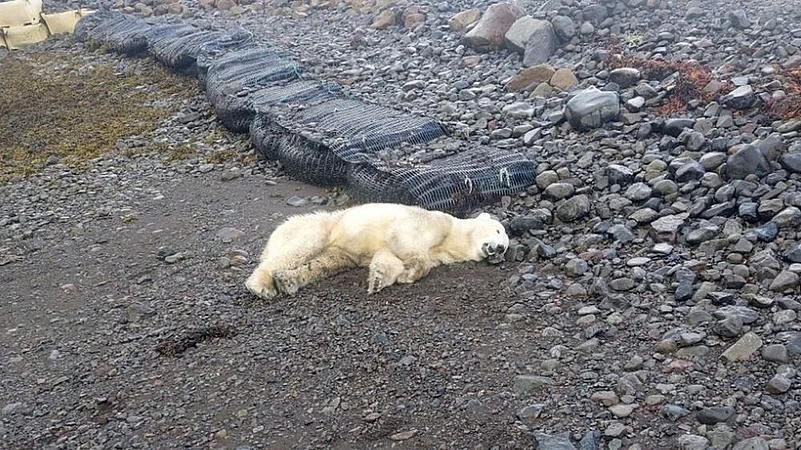A polar bear was shot and killed by local police after it was spotted near a summer cottage in a remote village in the Westfjords region of Iceland. The incident occurred on a Thursday afternoon, and the authorities, after consulting with the Environment Agency, determined that the bear posed a threat to local residents.
This incident has sparked a broader conversation about Iceland's polar bear policy, the impact of climate change, and the complexities of wildlife management.
What was the incident?
The polar bear was discovered close to a summer house where an elderly woman was spending her summer. Helgi Jensson, the Westfjords Police Chief, explained that the woman was alone when the bear began rummaging through her garbage. Out of fear, she locked herself upstairs and contacted her daughter in Reykjavik via a satellite link, asking for assistance. Most summer inhabitants had already departed for the season, but she chose to stay, unaware of the danger that lurked outside.
Upon receiving the call, local police took immediate action. They deployed a Coast Guard helicopter to survey the area for other potential bears, ensuring that the situation could be controlled. Jensson emphasized the gravity of the situation, stating, “It’s not something we like to do. In this case, the bear was very close to a summer house, and there was an old woman there.”
The young bear weighed between 150 and 200 kilograms (300 to 400 pounds), and will be taken to the institute to study. Scientists took samples from the bear Friday.
Polar Bears in Iceland’s History
Polar bears are not native to Iceland. These magnificent creatures typically inhabit the Arctic regions, relying on sea ice for hunting, resting, and breeding. However, they sometimes travel from Greenland on ice floes or swim the roughly 300-kilometre distance to Iceland. While encounters are rare, there have been documented sightings throughout Icelandic history.
According to Anna Sveinsdóttir, the head of scientific collections at the Icelandic Institute of Natural History, polar bears occasionally come ashore in Iceland, drawn by the shifting ice conditions caused by climate change. As the planet warms, the sea ice that polar bears depend on for survival is melting, forcing them to search for food on land. This shift has resulted in increased conflicts between bears and humans, particularly in areas where people reside.
Iceland's Polar Bear Policy
Icelandic law protects polar bears, but it also recognises the need for public safety. According to the law, while polar bears are generally protected, they can be killed if they pose a threat to humans or animals. The current policy reflects the delicate balance between ensuring the safety of residents and conserving wildlife.
In 2008, the arrival of two polar bears in Iceland prompted the environment minister to form a task force to explore alternatives to killing these rare visitors. The task force aimed to assess the feasibility of capturing and relocating polar bears rather than resorting to lethal measures. However, the logistics of such operations are complex and fraught with challenges.
When polar bears are spotted, local authorities are responsible for making the final call. In most cases, the local police take charge, assessing the situation to determine if the bear is a threat. So far this century, three of the four polar bears killed in Iceland have been shot by local police, while one was shot by a farmer who encountered the animal near a small town.
The Broader Implications of Climate Change
A 2017 study published in the Wildlife Society Bulletin highlighted that the loss of sea ice due to global warming has led to more polar bears venturing onto land in search of food, which in turn raises the risk of dangerous encounters with humans. Over the years, there have been approximately 73 recorded polar bear attacks in Canada, Greenland, Norway, Russia, and the United States, resulting in 20 fatalities and 63 injuries. Notably, 15 of these attacks occurred within the last five years of the study period, suggesting a worrying trend.
Sightings of polar bears have been infrequent in Iceland. Since the ninth century, only about 600 sightings have been reported, making encounters especially significant. When a polar bear does appear, it often causes alarm and prompts swift action from local authorities. Iceland's law allows for the killing of polar bears if they are deemed a threat to human safety or livestock, which has led to intense discussions about wildlife management and conservation.
International Perspective and Conservation Concerns
The international community has placed increasing pressure on nations to protect polar bears, especially as they face existential threats from climate change. In the United States, polar bears have been listed as a threatened species due to the ongoing loss of their sea ice habitat. This classification reflects global concerns about the long-term survival of the species.
The International Agreement on the Conservation of Polar Bears governs the conservation efforts of polar bears in five nations: Canada, Denmark/Greenland, Norway, Russia, and the United States. Despite the estimated 22,000 wild polar bears worldwide, hundreds are legally killed each year under this agreement. Iceland's polar bear policy, therefore, occupies a unique position in this broader conservation landscape.
While the killing of polar bears in Iceland has drawn criticism, officials argue that these actions do not significantly impact the overall population. The death of a polar bear on Icelandic soil is seen as a localized incident rather than a threat to the species as a whole.
Challenges of Relocation
Some wildlife advocates have suggested tranquillising and relocating stray polar bears to prevent lethal outcomes. However, this option presents its own set of challenges. Greenlandic authorities have expressed scepticism about the feasibility of relocating polar bears, noting that capturing a polar bear alive requires immediate action and specialized equipment.
The Ministry for the Environment in Iceland has reached out to Greenlandic authorities regarding potential relocation options. An expert group was commissioned to evaluate the feasibility of capturing and transporting bears. However, the complexities involved in such an operation are substantial. For instance, the bear must be contained quickly and safely to avoid posing a danger during the capture.
The expert group concluded that the chances of successfully capturing a polar bear alive are low due to various circumstances. The need for rapid containment, a trained crew, and the health of the bear are all critical factors that can affect the outcome of such an operation.


























